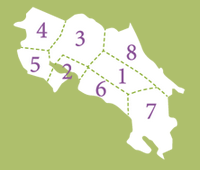Costa Rica overview
A full brief about Costa Rica, its people, culture, history, nature, economy, land and more.
Costa Rica is incredibly natural diverse country with a widely diverse culture, people, history, and geography.
Also, Costa Rica has major social, economic and political factors affecting local and international visitors, residents and business owners.
Costa Rica has two coasts and with that, two main cultures. On the Pacific Ocean, typically are the Ticos (Costa Ricans) and on the Atlantic Ocean, especially in and around Limon, is an English-speaking, Jamaican influenced African-Caribbean culture.
A high altitude change throughout the central part of the country offers all ranges of precipation levels creating hundred of mico climate zones. If the desire is to experience a warm and dry climate with seasonal changes, or a jungle to still see the autumn colors in a variety of trees, then the dry forests of the northwest Pacific Coast of Costa Rica in the Guancaste province could be your choice. Tropical climates along the coasts to highland climates occur in all altitudes throughout the mountainous country offering the greatest variety of temperature zones; one of them surely will fit your definition of "perfect climate".
Costa Ricans take great pride in their country and are very honest people. The relatively low crime rate and multitude of natural diversity within such a small space makes living there an experience filled with beauty and excitement. The country offers four types of rain forests and over 60 clearly recognizable volcanoes.
Costa Rica, meaning "Rich Coast", was the first country in the world to constitutionally abolish the use of a national army. Costa Rica ranks 4th in the Human Development Index, among Latin America countries. In terms of the Environmental Performance Index, Costa Rica ranks 5th in the world and number one in the Americas. Purchasing Costa Rica Properties / Real Estate is popular especially amongst North Americans and Europeans for several reasons.
Costa Rica has a total of 51,100 sq.km (19,730 sq.mil) and possesses the greatest density and biodiversity of species in the world.
The highest point in the country is Cerro Chiripo at 3,820 metres (12,532 ft). The highest volcano in the country is the Volcan Irazu (3,431 m / 11,257 ft) and there are about 60 recognizable Volcanoes with several still active.
Country Overview
Costa Rica has two coasts and with that, two cultures; on the Pacific Ocean you will find the Ticos (Costa Ricans) and on the Atlantic Ocean, especially in and around Limon, it is an English speaking; Jamaican influenced African-Caribbean culture.
A high altitude change throughout the central part of the country offers all ranges of climates. If the desire is to experience a warm and dry climate with seasonal changes, or a jungle to still see the autumn colors in a variety of trees, then the dry forests of the northwest Pacific Coast of Costa Rica in the Guancaste province could be your choice. Tropical climates along the coasts to highland climates occur in all altitudes throughout the mountainous country offering the greatest variety of temperature zones; one of them surely will fit your definition of "perfect climate".
Costa Ricans take great pride in their country and are very honest people. The relatively low crime rate and multitude of natural diversity within such a small space makes living there an experience filled with beauty and excitement. The country offers four types of rain forests and over 60 clearly recognizable volcanoes.
Costa Rica, meaning "Rich Coast", was the first country in the world to constitutionally abolish the use of a national army., Costa Rica ranks 4th in the Human Development Index, among Latin America. In terms of the Environmental Performance Index Costa Rica ranks 5th in the world, and number one in the Americas.
Costa Rica's has a total of 51,100 square kilometers (19,730 square miles) and possess the greatest density and diversity of of species in the world.
The highest point in the country is Cerro Chiripo at 3,820 metres (12,532 ft), being the fifth highest peak in all of Central America. The highest volcano in the country is the Volcan Irazu (3,431 m / 11,257 ft).
Costa Rica has one of the most advanced telecommunications systems in Latin America with telephones and fax machines all over the country and an increasing number of businesses online. To call or fax Costa Rica, dial the country code 506; cell phones now start with a 8 and land lines with a 2 before the 7 digit phone number you want to call. There is also mail service and an ample selection of courier services in San Jose. Most large hotels have cable television with U.S. and European stations. Newspapers and magazines from North America and several European nations are sold in many shops and hotels in and around the capital. It is easy to get around Costa Rica, and if you stick with public transportation, traveling within the country can be quite inexpensive. There are bus services to just about every town and city. Taxis are plentiful and inexpensive, and in San Jose, they are required to use meters for most trips. The quickest way to get around is to fly, and several domestic airlines offer daily flights to most of the popular tourist destinations. Sansa and Nature Air are two from which to choose. There are also plenty of car rental agencies spread throughout the tourist concentrated regions of the country most of which rent four-wheel-drive vehicles.
Geography: Costa Rica has a total land mass of 50,660 square kilometers with a total of 639 kilometers of border line shared by Nicaragua to the north and Panama to its south. Costa Rica has a tropical and subtropical environment with four different types of forests and a proportional large area of coast line for its size with a total of 1290 km. The climate varies greatly depending on location-dry in the northwest, hot and humid on either coast line and cooler in highlands. The elevation extremes are enormous for such a small country. Central America was created volcanic eruptions which created the bridge between North and South America making it possible for animal migration. Through the last Ice-Age the largest biodiversity survived in and around Costa Rica. Of this historic volcanic activity, at least sixty volcanoes are found in Costa Rica. The highest mountain peak is Cerro Chirripo with an altitude of 3810 meters (app.11,500ft). Costa Rica has overall a very stable temperature despite its seasonal changes, with the dry season lasting from December through April and the rainy season from May through November
Environmental overview: Some international agreements Costa Rica is party to are: Biodiversity, Climate Change, Desertification, Endangered Species, Environmental Modification, Hazardous Wastes, Law of the Sea, Marine Dumping, Nuclear Test Ban, Ozone Layer Protection, Wetlands, Whaling signed, but not ratified: Climate Change-Kyoto Protocol, and Marine Life Conservation
Article courtesy of CostaRica-Information.com



